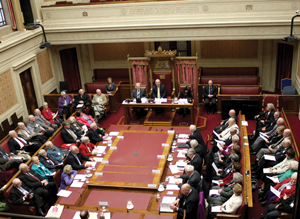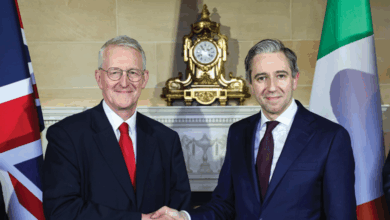Age Sector Platform: health priorities
 The Northern Ireland Pensioners Parliament finds that one in three older people are worried about access to health and social care.
The Northern Ireland Pensioners Parliament finds that one in three older people are worried about access to health and social care.
Health and social care was one of three key areas discussed at a recent debate at Parliament Buildings, which was attended by around seventy Members of the Pensioners Parliament (MPPs). The debate, which took place in the Senate Chamber, followed on from the highly successful Northern Ireland Pensioners Parliament held earlier this year which saw twenty four motions being passed by older people from across the province.
The debate at Stormont, which took place at the end of November, was hosted by the Speaker of the Northern Ireland Assembly, William Hay MLA, and allowed MPPs to put forward three motions – on fuel poverty, fear of crime and health and social care – to the relevant departments in the Northern Ireland Executive. Each department then provided an official response to the motions through Social Development Minister Nelson McCausland, Stephen Farry (on behalf of Justice Minister David Ford) and Jonathan Bell (on behalf of Health Minister Edwin Poots).
The motion on health and social care called on the Health Minister to “increase funding for preventative healthcare programmes to help maintain the quality of life and independence of older people living at home; to take action to reduce hospital waiting times for older people and provide better support services for older carers”.
The Northern Ireland Pensioners Parliament survey, earlier this year, asked over 1,200 older people to select their top five concerns from a list of 16 issues. Almost one in three (31per cent) older people chose ‘access to health and social care’ as a concern for them, which highlights the need for action in this area.
Patricia Donald, Chair of Age Sector Platform, said: “Issues relating to health and social care become even more important as we get older, and it is clear from our dialogue with older people during the Pensioners Parliament that there is a lot that can be improved in our health and social care system.”
“Many older people are concerned about the current level of social care provision and its ability to meet the needs of older people now and in the future. Unfortunately, we heard many stories from older people across the province who have experienced cuts in home help provision, a lack of support for them as older carers and poor communication with them and their families from social workers. These issues must be addressed.”
“During the Northern Ireland Pensioners Parliament, there was a real recognition of the value of preventative healthcare in helping to ensure older people remain independent – something which older people want more than anything. Our health and social care system must ensure that older people who want to remain at home are able to do so. In the long term, social care as a preventative measure could save the Government huge sums of money by reducing the number of hospital admissions. The value of older people’s groups and their ability to prevent ill-health must also be recognised. These groups must be supported so they can continue the essential role they play in keeping older people active.”
“Some regional health issues which were raised during the local parliaments held in each county included concerns regarding the closure and downgrading of regional hospitals, inadequate transport options for older people travelling to hospital and health appointments, and concerns regarding the provision of food in some hospitals. These regional issues were discussed fervently at the local parliaments and must be explored by the Health Minister.”
“Unfortunately, age discrimination in our health service appears to be relatively common, based on the experiences of older people who attended the Pensioners Parliament. Many older people spoke of being ‘patronised’ and some claim to have been refused treatment purely because of their age. We are delighted to see that the Northern Ireland Executive has committed to bring forward legislation to outlaw age discrimination in the provision of goods, facilities and services. This legislation will mean that it will be illegal to refuse healthcare to someone simply based on their age.”
For more information on Age Sector Platform visit www.agesectorplatform.org or phone 028 9031 2089.





